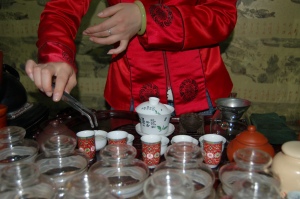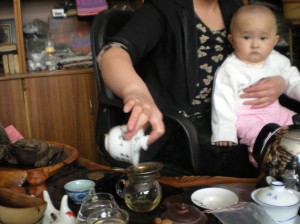Fellow Tea Lovers,
Now that I am back in the States, I have more time on my hands than I would I like. This has led me to reminisce and go through all my meticulously kept tea journals and take a trip down memory lane, back to a time when I was a Chinese tea novice, revisiting all the experiences, good and bad, that led me to become the Tea Gal that I am today.
My first real tea experience in China happened shortly after I arrived in March of 2007. Having been in China for a month, I decided to make my way to Shanghai to see what all the fuss was about. Boy, they have a lot to be proud of. One of the largest cities on the mainland with a population of 23 million, Shanghai has everything. Restaurants, shops, malls, skyscrapers, tiny winding lanes, large neon-filled avenues, street vendors, clubs, bars, building after building after building…it seems never ending at times. I could talk about Shanghai at great length, but I will save myself the trouble and simply recommend one of my favorite expat-run websites so you can discover it for yourself:
http://www.echinacities.com/shanghai/
As soon as I left the train station, I knew that I was somewhere special, a true Asian metropolis. I was so excited. Even with my non-existent Chinese I managed to get around by showing passers-by my desired destination in my Lonely Planet, raising my shoulder and arms into the air with a “WHHAAA??” expression on my face.
Since I looked pretty harmless and fairly lost, people pointed out the right direction to go in and eventually with the help of the many English sings in and around People’s Square I found my first sight: The Shanghai Museum. I had heard that it was one of the best museums in China and was not disappointed. Filled with a dozen exhibitions, including coins, calligraphy, paintings, ceramics, furniture, this museum was the perfect introduction to ancient Chinese culture. And the gift shop! My inner shopaholic swooned to see books, clothing, jewelry and a plethora of things one does not need, but definitely wants. After living in China for 6 years, I now know where to buy all these things for much less, but if you only have 48 hours in Shanghai, what a gold mine that shop is! Check out the museum here:
http://www.chinamuseums.com/shanghai.htm
I exited the museum, my head swimming with all that I had just seen, and sat on the stoop for a smoke and a ponder. Just as I was wondering where to go next, I was approached by three lovely young women, claiming to be students on holiday in Shanghai for the first time. Now, for those of you who have been to China, or who have been living in China, you don’t need me to say much more than “three students came up to me in the street” to know that I was about to experience the classic Shanghai scam. Well spoken, bilingual young people roam the streets of Shanghai and Beijing, chatting up locals and try to sell them anything from paintings to guided tours of the cities. There are hundreds of tales recounting tea related scams in China, http://www.tripadvisor.com/Travel-g308272-c108782/Shanghai:China:Scams.html, http://blog.chinatravel.net/china-travel-tips-advice/shanghai-beijing-tea-house-scam.html, some more horrifically expensive than you can imagine. I was new to China, but my years of travelling told me that something was up. Who goes up to a stranger in the street and offers to take them around for no apparent reason? I was about to stand up and leave, when one of the young women said the magic word: tea.
Now, I had come to China with the express intent of learning more about tea, but I had no idea how to get started. Without the language, or knowing anyone, how was I going to accomplish this? I had been to a few tea shops and used what little I knew to help me purchase small quantities of tea where I could. But this was a golden opportunity. Three girls with good English, willing to take me to a tea house to try tea. How could I refuse?
So I followed them down a series of confusing streets and never ending alleys until we finally reached a run-down looking building near Nanjing Lu. On the third floor, we entered a beautifully decorated tea house filled with traditionally dressed attendants, all waiting to serve me what they called “the finest and most authentic tea that China had to offer”. We sat down before a table filled with different kinds of teapots and glasses, and our attendant started pouring different kinds of teas in the most elaborate ways possible.

My scammer hard at work
I was so excited! I was going to have real Chinese tea prepared in the traditional way! I couldn’t wait. I drew the first cup up to my lips, took a sip and …meh. Banal. Uninteresting. Weak. I was disappointed, but decided to wait for the second cup before saying anything. My three “students” were chatting, asking me how I liked it, how I liked the tea ware, and other small talk. I remained pleasant, all the while confirming to myself that I was, in fact, being scammed. I decided that it was time to let them know that I knew quite a bit about tea, and that I would appreciate a higher quality brew. They looked at me quizzically, poured me another cup of dried fruit tea (blah), and hoped that would make me happy. It did not, and asked again for something more interesting.
At this point, they realized that I did know what I was talking about when it came to tea, and served a higher caliber tea: a Long Jing from Hangzhou. Finally! I was trying a tea I had wanted to sample ever since I had arrived in China. I was enjoying it and thanking them for the superior tea when they brought the bill: 1 600 RMB! About $200 CAN. I couldn’t believe it! Since I had been drinking and buying Chinese tea in Canada since I was 14, I knew exactly how much the teas I had been served cost. I was incensed. The whole thing should have cost around 200 RMB. I had been scammed and good.
As the anger boiled up inside me I decided that I had two options before me: I could refuse to pay and get into a fight, or…I could get my money’s worth. Since I am someone who hates conflict and would rather learn from her mistakes than cause a scene, I decided that these lovely young women were going to start providing me with some much needed information.
Pushing the bill to the side of the table, I pulled out my tea notebook and started asking questions. Where were these teas picked? How were they picked? How were they processed? What type of rolling techniques were used? How long should each tea be steeped for? What type of water should be used? How long could one keep the teas in a pantry? What were the Chinese names for these teas and how were they written? How would one ask for a specific tea in a tea shop? Was I using the right tones? And on and on and on…
Those poor girls. They never saw it coming. For 2 hours I sat there having my tea re-filled with hot water, asked every question I had about tea and the Chinese language, keep a sunny disposition and got the information I needed. Every time they would bring up the bill, I would smile and say I just had a few more questions, and would they be so kind as to write down the Chinese characters for this and that. When we started heading into hour 3, the smallest of the group abruptly stood up, put her bag on her shoulder and said: “We have to go.”
I stoop up, paid my bill and left. My three scammers left without me, hurrying down the stairs as fast as their legs could carry them. I had clearly wasted their time and they had lost several hours finding new marks to take advantage of. That’s what you get girls:)
I was elated. I left that shop with so much information and the Chinese characters I needed to start buying tea more seriously. I left that shop feeling that I knew…everything. Well, not everything, but I finally had a starting point! Something to work with for the first time since I had arrived in China.
So yes, I had been ripped off, but on my own terms. People had tried to take advantage of me, and paid I them back in kind. I got what I wanted out of the experience, all while staying positive. It was great. Besides, every expat living in China has their own “the first time I got ripped off in Shanghai/Beijing…” story, and now, I had one as well:) It was like a rite of passage, and I got something out of it.
So, it’s true what they say: when life gives you lemons, make lemonade. And when someone gives you a bad cup of tea, demand a better one!:)

